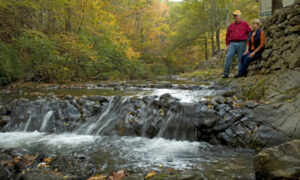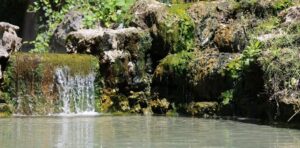
The entire Bathhouse Row area is designated as a National Historic Landmark District that contains the grandest collection of bathhouses of its kind in North America, including many outstanding examples of Gilded Age architecture.
Members of many Native American Tribes had been gathering in the valley for over 8,000 years to enjoy the healing properties of the thermal springs.
Since Hot Springs National Park is the oldest park maintained by the National Park Service, it was the first to receive its own US quarter in April 2010 as part of the American Beautiful Quarters Coin series.
The lowest elevation found in Hot Springs is 415 feet at Bull Bayou

The highest elevation found in Hot Springs is 1,405 feet on Music Mountain
The part of the park not within the city is mostly covered with forested hills and valleys. It is primarily made up of oak, hickory, and pine, with many other species as well. Wildflowers and flowering trees put on a beautiful show in the spring.
The spring water flowing from Hot Springs Mountain is quite safe to drink. The National Park Service has several places where visitors can fill their own bottles with water.
It is estimated that the water emanating from the hot springs is first heated a mile below the Earth’s surface, and slowly rises through a fault.
Hot Springs were commonplace for baseball spring training in the late 1800s through around 1940. The players used the many bathhouses and the water’s reported curative powers to get ready for the season.
Touch the Thermal Springs
Within the Park, there are 2 places where you can touch the thermal water. Even though the water comes out of the ground at 147 degrees F, it is cool enough to touch by the time it reaches the pools.
The thermal water at Hot Springs National Park is nearly 4,000-year-old spring water in its natural state. The water’s high temperature kills the most harmful bacteria, and it is monitored to U.S. standards for safe drinking water. Bacteria may still be present and could affect those with compromised immune systems or other medical conditions if water is inhaled.
Drink the Water
Water from the hot springs in Hot Spring’s National Park’s primary resource. Congress first protected the hot springs in 1832 and is intended for the water to be used.Drinking the hot springs water is perfectly normal, even encouraged. People tend to think of it as an elixir.
Thermal Spring Fountains
- In front of the Libbey Memorial Physical Medicine Center on Reserve St. – suitable for filling jugs.
- In front of the National Park Service Administration Building on Reserve St. – suitable for filling jugs.
- Between the Hale and Maurice Bathhouses on the Bathhouse Row
- The Noble Fountain on Reserve St. (at the south entrance of the Grand Promenade)
- The Dripping Spring between the Hale and Maurice Bathhouses
- The Shell Fountain on the Stevens Balustrade (between the Fordyce and the Maurice Bathhouses)
- Outside the park boundaries at the Hill Wheatley Plaza on Central Ave. – suitable for filling jugs.


